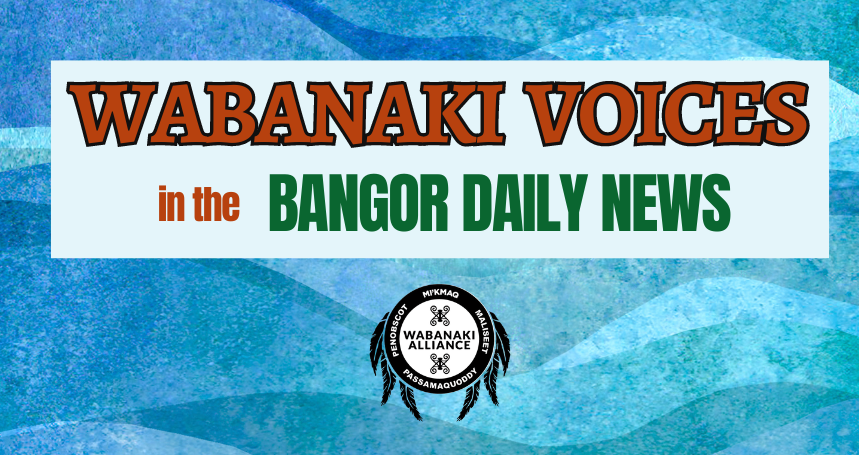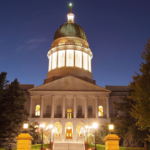The July Wabanaki Voices column was written by Osihkiyol Crofton-Macdonald, the tribal ambassador for the Houlton Band of Maliseet Indians and a co-commissioner on the Maine Indian Tribal-State Commission. Wabanaki voices is a monthly column in the Bangor Daily News opinion section that shares tribal perspectives. Read all Wabanaki Voices columns here.
July is the month Americans celebrate independence, but it is also the month we should celebrate the signing of the Watertown Treaty of 1776. I first learned of this treaty from elders in my community. I’m a Wolastoqey (Maliseet) person from Metaksonekiyak (the Houlton Band of Maliseet Indians) and Welamukotuk (Oromocto First Nation in New Brunswick, Canada). I grew up proud of my nation’s treaty history. The history of the Watertown Treaty is rarely told from a Wabanaki perspective. I wanted to take this time to share our side of the story and perhaps share a side of the story you haven’t heard.
Here in Maine, the story is usually told from the American perspective. On July 19, 1776, two weeks after the signing of the Declaration of Independence, the United States, in the midst of the Revolutionary War, signed its first international treaty with a foreign nation. Gen. George Washington had developed a positive relationship with the Penobscot, Wolastoqey, Passamaquoddy and Mi’kmaq Nations, and Congress requested the state of Massachusetts Bay to negotiate a treaty on the country’s behalf. The intention of this effort was to muster as many warriors as possible from the Wabanaki Nations to join Washington’s forces in New York.
From the Wabanaki perspective, however, the story begins far earlier. Fifty years prior to the outbreak of the American Revolution, the Wabanaki Nations, acting as a unified confederacy of nations, had entered into a treaty relationship with the British crown declaring that the British would not impact Wabanaki hunting, fishing, planting and harvesting territories in exchange for international peace and friendship.
Over the course of the 18th century, the British crown had repeatedly broken these treaties, expanded into Wabanaki sovereign territory, negatively impacted Wabanaki hunting and fishing rights, and refused to honor trade agreements. In the early months of the American Revolution, Washington and the state of Massachusetts Bay presented themselves to the Wabanaki Nations as alternative governments that would honor these ancient agreements on more equitable terms. From the perspective of the Wolastoqey Nation, a key aspect of this agreement had been a fixed price table for furs traded out of British truck houses, or trading posts, as established in the Treaty of 1760.
The state of Massachusetts Bay had begun to operate truck houses at Machias and Penobscot Falls to trade with Wabanaki people independent of British imperial influence. Wabanaki trade quickly overwhelmed the truck house operators and on July 10, 1776, a coalition of 10 ambassadors from the Wolastoqey and Mi’kmaq nations traveled to Watertown, Massachusetts, to negotiate an increase in supplies available in Machias, and to communicate their support for the American Revolution.
On July 19, 1776, representatives from the Wolastoqey and Mi’kmaq Nations met with the governors of the state of Massachusetts Bay and signed a “Treaty of Alliance and Friendship.” In this treaty, the U.S. outlined the terms of enlistment for a new regiment to be composed of Wabanaki and American soldiers to join the Continental Army. The Wolastoqey and Mi’kmaq delegates agreed to rally as many warriors as possible from their nations to join this regiment. In return, Massachusetts promised to resupply the truck house located at Machias and trade goods for furs with Wabanaki citizens.
A year later, Wolastoqey and Passamaquoddy warriors fought alongside Continental Army forces in a battle remembered as the Battle of Machias of 1777. It was a proud moment of international alliance in American history, but we also can’t forget the history that immediately followed.
Despite the Watertown Treaty of 1776, and other international treaties the U.S. signed with other Indigenous allies during the American Revolution, not a single Indigenous nation was invited to negotiations leading up to the signing of the Treaty of Paris of 1784, the treaty which formally ended the American Revolution and attempted to draw new borders between the U.S. and the remaining British colonies.
Despite words of alliance and friendship when they needed wartime assistance from Indigenous allies, the U.S. and Great Britain divided the entirety of the territory between themselves. Indigenous national and territorial claims were seen as matters for domestic policy decisions after the real international diplomacy had concluded between them. This moment would foreshadow the next two centuries’ worth of American-Indigenous relations in North America.
Let’s honor and celebrate the history of the Watertown Treaty of 1776 as a moment of international cooperation, but let’s not forget the full history of American-Indigenous relations on this land. It has been a relationship of injustice. Yet there is always hope for a better future. One where we honor justice and work to mend our relationship on this land together. Despite it all, we are still here, and we will always be here. Our future must finally be crafted side by side as friends and equals.





